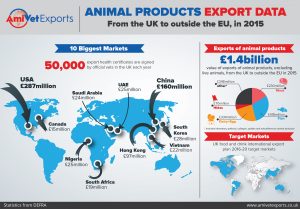The world is a big place, and knowing where to find the largest export opportunities can be daunting for both first time and seasoned exporters. This blog post aims to give you a deeper insight into export opportunities around the world, and the requirements that you need to meet in order to maximise the growing demand for quality British exports.

I’m new to exporting, where should I be focusing my exports?
Today, as well as the European single market, countries which represent significant food export potential include Australia & New Zealand, Mexico and Latin America, India, USA and Canada, China, Japan and the UAE & Gulf region.
In 2015, exports of animal products outside of the EU reached £1.4 billion, with top markets including the USA (£287 million) and China (£160 million). The infographic above shows the value of the UK’s 10 biggest animal product export markets, and as you can see there is a whole world of opportunity.
Can you give me a little insight into the direction that food exports are heading?
Over the next 5 years, the government is actively seeking to rapidly grow the food and drink export industry, with the USA and China being key target markets. According to DEFRA’s UK Food and Drink International Action Plan, their aim is to add a massive £984 million of additional food exports to these two markets alone.
If I’m looking to export outside of the European Single Market, what do I need to watch out for?
When exporting outside of the European Single Market, you need an Export Health Certificate. We’ve covered these in detail in our previous blogs, but to give you a quick overview, there are over 1,500 certificates available, and they all have slightly different requirements. Each year, over 50,000 export health certificates are signed by official vets in the UK, and they are split into a range of commodities:
- Meat (£230 million in 2015)
- Dairy (milk, whey, yoghurt, cheese, butter & ice cream) and Eggs (£334 million in 2015)
- Hides, skins, wool, feathers & lanolin (£70 million in 2015)
- Fish and fishery products (£418 million in 2015)
- Others (£348 million) including:
- Collagen, gelatin & casings
- Laboratory
- Pet food and animal feeds
- Miscellaneous
How do I know which Export Health Certificate I need?
At Amivet Exports, we’ve developed an easy to use Export Certificate tool, which will help you to easily find which Export Health Certificates you require. If there aren’t any available, then you can contact your trade association and DEFRA/APHA to request one.
How can Amivet Exports help me with finding new export markets?
We have many years experience in guiding clients through the export certification process. Our friendly team of export vets can provide you with a competitively priced, high quality service tailored to your individual needs. We provide a full advisory service, which includes research into new markets, along with a detailed report of the opportunities that they present.
Are there other organisations that can help me with my exporting goals?
We work closely with DIT, the Chamber of Commerce, UKFDEA, and many other organisations to comply with other documentation and to find buyers. As part of our advisory service you will be able to tap into our knowledge to achieve exporting success.
Start exporting today
If you think that you’re ready to start your exporting journey today, contact us for an initial phone or email consultation with our experienced veterinary team.
Witten by Andrew Iveson on and tagged in